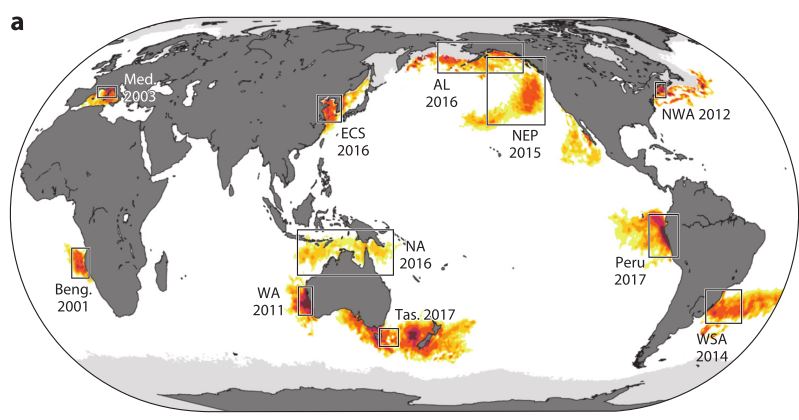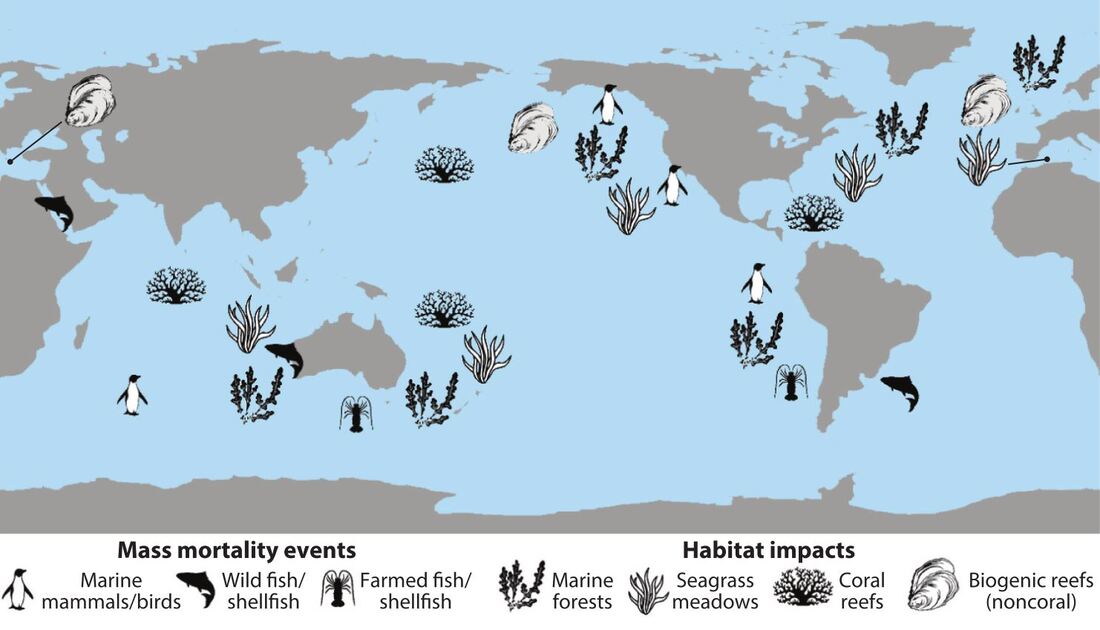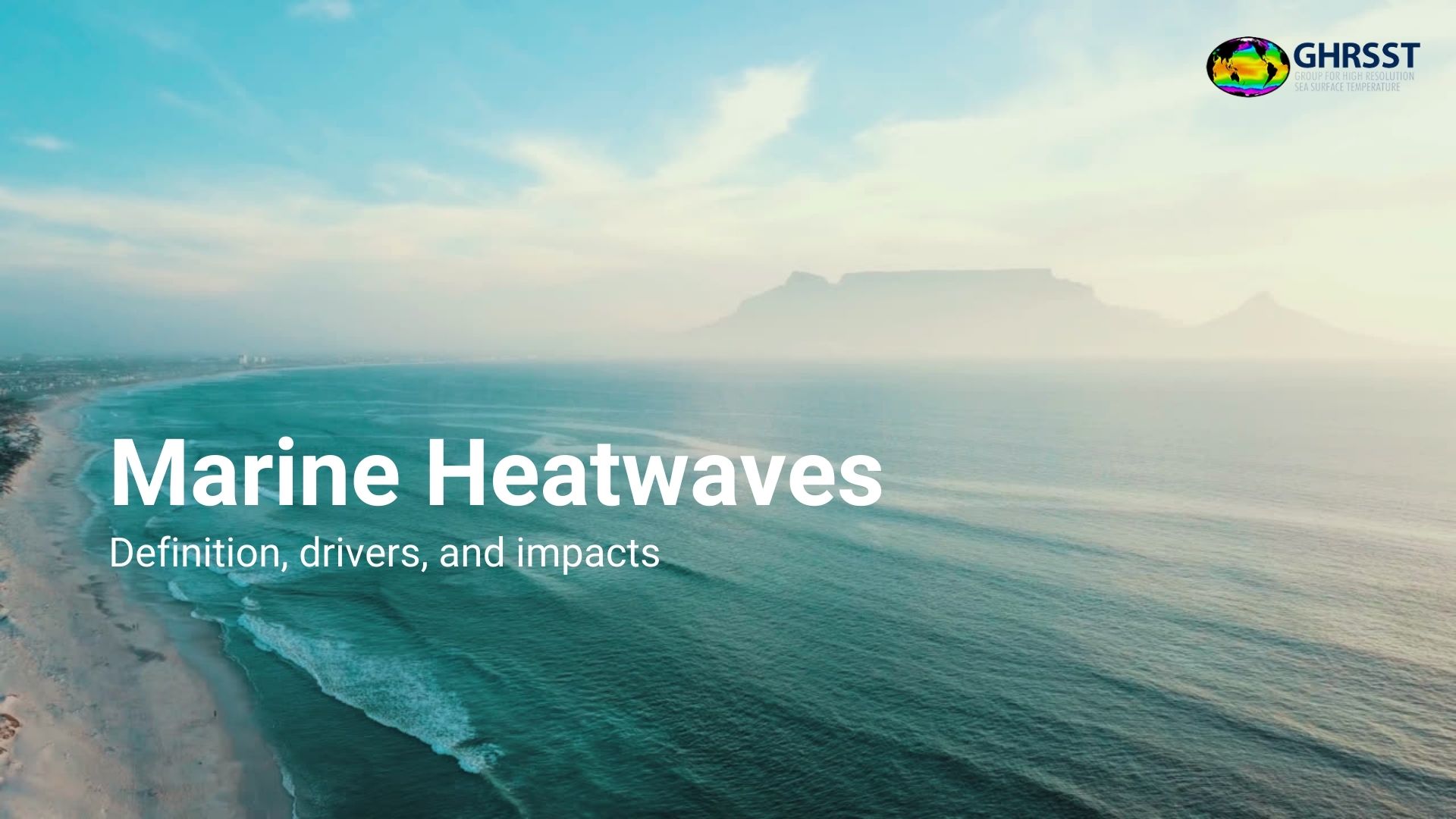What is a Marine Heatwave?
The widely used definition for Marine Heatwaves (MHW) was proposed by Hobday et al. (2016) where a MHW event is a discrete period of prolonged anomalously warm water for a given region. Accordingly, MHWs occur when the mean Sea Surface Temperature (SST) for a particular location exceeds thresholds relative to a baseline period (climatology). The climatology is calculated relative to the day of the year, often centered within an 11 day window. MHWs should last at least five days with well-defined start and end dates and with no in-between gaps of more than two days. The events can be further characterized using summary statistics such as frequency, intensity, duration, and spatial extent.
Video explanation from Planet Tuna on Marine Heatwaves. Video Source: Planet Tuna, Marine Heatwaves, https://planettuna.com/en/marine-heatwaves/
Why Do They Happen?
Delving into the drivers behind MHWs reveals a complex interplay of various natural and human-induced factors.
MHWs are influenced by a range of factors on local as well as global scales (Holbrook et al., 2019). Local phenomena such as temperature fluxes between the atmosphere and the ocean as well as horizontal heat transport like Ekman advection play significant roles in triggering and sustaining MHWs (Oliver et al., 2017). On a global scale, large-scale climatic patterns such as the combined forces of hydrodynamics and atmospheric dynamics, along with global-scale teleconnections play a dominant role in driving MHWs (Holbrook et al., 2019).

Figure: Drivers of Marine Heatwaves across space and time scales. Image source: From “A global assessment of marine heatwaves and their drivers” by Holbrook, N.J., Scannell, H.A., Sen Gupta, A. et al., Nature Communications 10, 2624 (2019). https://doi.org/10.1038/s41467-019-10206-z
Among the prominent global climatic patterns, the El Niño Southern Oscillation (ENSO) and the Atlantic Multidecadal Oscillation (AMO) are strong influencers on MHWs (Pearce and Feng, 2013; Eakin et al., 2019; Holbrook et al., 2019;). A notable example linked to ENSO is the 2014 MHW in the Northwest Pacific, known as the “Pacific Blob” (Bond et al., 2015; Lorenzo and Mantua, 2016). ENSO, in particular, emerges as a significant driver of MHWs globally, associated with warming events also in the Atlantic and the Southern Ocean. However, despite these natural drivers of MHWs, human-induced global warming plays an increasingly significant role in the intensification of MHWs (Laufkötter et al., 2020).
Where Do They Happen?
Marine heatwaves are not confined to specific regions; they occur worldwide, from the Mediterranean Sea to the Arctic (Oliver et al., 2021).

Map of Marine heatwave events across the globe and time. Image source: From “Marine Heatwaves” by Oliver et al. (2021) in Annual Review of Marine Science, https://doi.org/10.1146/annurev-marine-032720-095144
At the 24th International SST User Symposium, Andrea Pisano from the National Research Council of Italy’s Institute for Marine Sciences, highlighted the notable instance of the unprecedented and record-breaking persistence of the 2022/23 Marine Heatwave in the Mediterranean Sea (Marullo et al, 2023). Key messages included:
- SST trend due to climate warming is the main responsible for the intensification of Marine Heatwaves in the Mediterranean Sea
- Marine Heatwaves under warming oceans: a proper definition (for a reference baseline) is needed to separate the long-term changes from abrupt and short variability
- The 2022 MHW was an exceptional event for duration and extension when compared with MHWs of the last 4 decades
- After a reduction in spring 2023, the Mediterranean MHW had re-intensified in July and August 2023
- In-situ observations offshore Lampedusa allowed for direct observation of the vertical propagation of MHWs highlighting the role of wind-induced mixing in the transferring of the surface heat to deeper layers
- We need to further study the role of atmospheric forcing, and in general, drivers for Marine Heatwaves and their impacts in ecosystems
Similarly, research conducted by Brenna Mei Concolis from the University of the Philippines Cebu shed light on the detection of marine heatwaves in the Philippines.
Key Messages:
- 75 MHW events from the detected 96 MHW events from 1981 to 2023 occurred in the last two decades, implying an increasing number of MHWs over the years
- Although mean annual hotspots for imean, imax, and icum were mostly confined in the West Philippine Sea and the western tropical Pacific, growth rates were higher in the east
- It is recommended to investigate the effects of ENSO on the development of MHWs in the Philippines
- Results of this study have implications for resource management – highlighting the need for monitoring, research and adaptive strategies.
Lastly, Kirsten Petzer from the University of Cape Town, Rondebosch, presented findings from her project on marine heatwaves in the Southern Benguela region.
Why Does it Matter?
Globally, MHWs have become more frequent and longer-lasting (Oliver et al., 2018; Frolicher et al., 2018) with the majority of these events being attributed to human-induced warming as suggested by Earth system model simulations (Frolicher et al., 2018; Laufkötter et al., 2020). In the case of continued greenhouse gas emissions, projections indicate that MHWs will become more frequent, severe, and intense by the end of the century (Frolicher et al., 2018; Plecha et al., 2020).
These trends raise serious concerns for marine ecosystems including shifts in species distributions, coral bleaching events, harmful algal blooms, and mass mortalities or beachings of marine mammals (Ummenhofer et al., 2017). Coral reefs are particularly vulnerable to MHWs, as elevated sea surface temperatures can trigger mass bleaching events and subsequent coral mortality. Even minor deviations, such as a 1°C increase above the expected summertime maximum, can stress corals and disrupt their symbiotic relationships with dinoflagellate algae, leading to bleaching and potential death.
The socioeconomic ramifications of MHWs are also noteworthy, with impacts extending beyond ecological damage. Loss of fishery income and the subsequent effects on local communities are among the socioeconomic challenges posed by these events.

Overview of biological impacts of marine heatwaves across the globe. Image source: From “Biological Impacts of Marine Heatwaves” by Smith et al. (2023). https://doi.org/10.1146/annurev-marine-032122-121437
How Can We Monitor, Detect and Predict Marine Heatwaves?
Monitoring, detecting, and forecasting MHWs rely on various tools, including satellite-derived SST data. This data not only provides insights into the complex dynamics of ocean temperature but also plays a crucial role in predicting and understanding MHWs. By observing SST, we can accurately forecast weather conditions and monitor environmental factors contributing to phenomena like mass coral bleaching and mortality, which are often triggered by MHWs. The availability of near real-time SST observations and corresponding anomalies enables scientists to anticipate and respond to potential bleaching events. By understanding the relationship between SST and coral health, researchers can better assess the risks posed by MHWs and implement strategies to protect vulnerable reef ecosystems.
Furthermore, this information aids in comprehending the broader impacts of climate change on our oceans. Through the utilization of this data in models and data records, we can enhance our understanding of long-term climate change trends and better prepare for extreme events such as marine heatwaves.

Mediterranean sea surface temperature from the Copernicus Sentinel-3 Sea and Land Surface Temperature Radiometer (SLSTR), 02.08.2023. Contains modified EUMETSAT Copernicus Sentinel-3 SLSTR data, 2024.
Contributors
Alexander Hayward, DMI; Erika Hayashi, GHRSST Project Office/DMI; Pia Englyst, GHRSST Project Office/DMI; Brenna Mei Conconlis, University of Cebu Philippines; William Skirving, NOAA; Ben Loveday, EUMETSAT; Hayley Evers-King, EUMETSAT
The Humming of Marine Heatwaves
A compelling short film crafted by the marine scientists of +ATLANTIC CoLAB, including GHRSST Science Team Member, Ana Oliveira, driven to present their research in a fresh, accessible format beyond traditional scientific avenues. This video intertwines oceanic data, footage, animations, poetry, and an evocative piano composition, mirroring the North Atlantic sea surface temperature trends over the past three decades.

